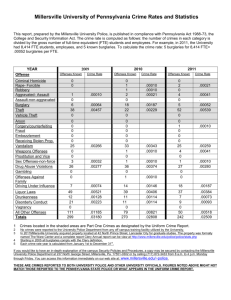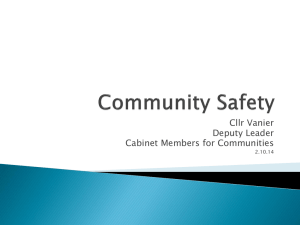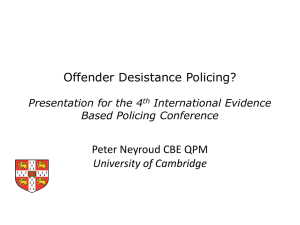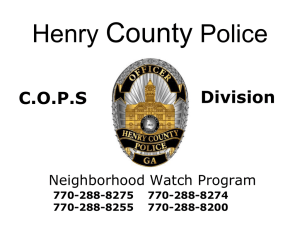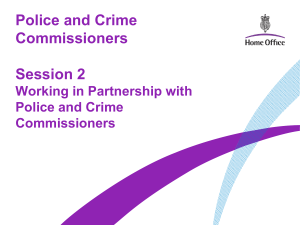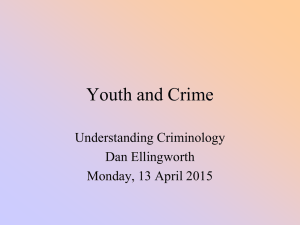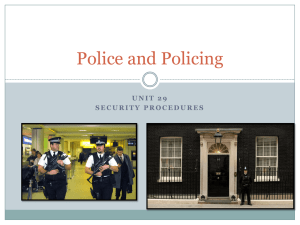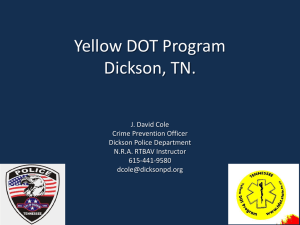Evaluating the Lancaster Violent Crime Reduction
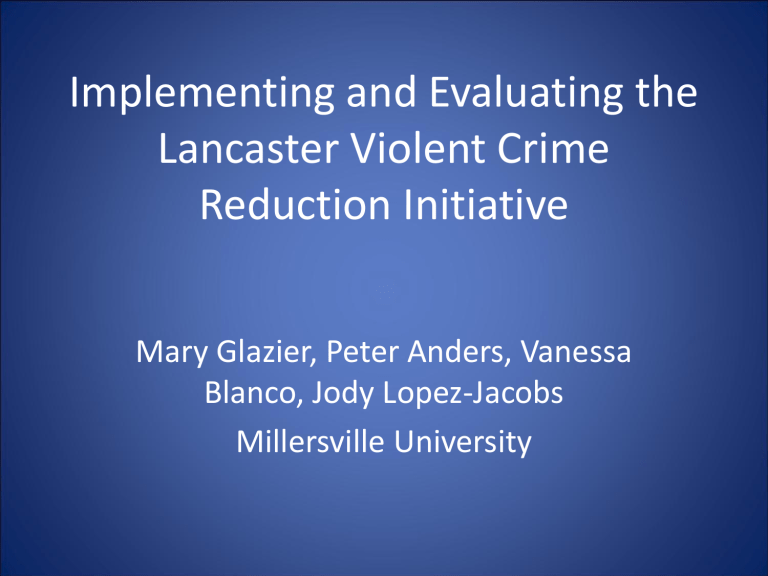
Implementing and Evaluating the
Lancaster Violent Crime
Reduction Initiative
Mary Glazier, Peter Anders, Vanessa
Blanco, Jody Lopez-Jacobs
Millersville University
Focused Deterrence Project
Goals
Reduce Violent Crime
Promote Community Mobilization
Improve Police-Community Relations
Project Time Line
Fall 2007-
Winter 2008
• Recruit Partners
• Visit High Point, North Carolina
Spring 2009
• Identify Target Area
• Police Make Undercover Drug Buys
Summer
2009
• Screen and Notify Offenders
• Call-in – August 20, 2009
Lancaster City Bureau of Police initiated project. Partners included--
• Office of District Attorney
• Lancaster City Mayor’s Office
• Lancaster County Adult Probation and Parole
• Pennsylvania State Parole
• Lancaster County Council of Churches
• Millersville University
• Pastors and Community Leaders
Target Area Selected
Crime data used to identify a target area within the southeast area of Lancaster city.
High rates of violent crime and drug-related crime present.
Target area also contained numerous house of worship and community agencies.
Implementation
Identification
• Selective Enforcement Unit makes drug buys from 20 offenders.
Screening
• Lancaster Bureau of Police Captain of
Patrol and Captain of Detectives select four without serious prior records.
Notification
• Police Captain and pastor or community leader invite each of the four offenders to the “call-in”
Terms of the Offer
Offenders must not sell or use If they agree, they will not be drugs. They will be drug tested.
arrested. Instead, they will be monitored and assisted.
They must find legal employment or return to school.
If they fail to live up to their end of the bargain, they will be arrested and prosecuted fully.
The Call-In
A judge addresses one of the offenders
Outcomes Measured
Offender Success/Failure
Crime Rates in Target Area
Community Perceptions
Police-Community Relations
Community Mobilization
Offender
Success/Failure
One failed a drug test after one month in the program.
One charged with theft after three months in the program.
Two successfully completed the program after two years.
Critical needs – housing, education, job-readiness training, mental health/mental retardation services.
Crime Incidents Reported
Before and After Call-In
Target Area Southeast Area
2007-
2009
Ag Assault 26
Ag Assault w/Gun
18
Robbery 22
Robbery –
Gun
13
Shots Fired 58
Weapons 46
Total 183
30
8
61
27
151
2009-
2011
15
10
%
Change
-42%
-44%
36%
-38%
5%
-41%
-17%
2007-
2009
Ag Assault 38
Ag Assault w/Gun
12
Robbery 35
Robbery-
Gun
Shots Fired 85
Weapons 98
Total
24
33
16
99
68
292 273
2009-
2011
35
22
%
Change
-8%
83%
-6%
-33%
16%
-31%
-7%
Changes in Community Perceptions
Community Surveys
1000 randomly selected households
• Before: May-July 2009
• After: September 2010
• N=140 for each survey
Two Focus Groups
Conducted 18 months after call-in
• Residents of target area
• Pastor, teacher, counselor
• Diverse ages
• Black, Latina/o, White
Statistically Significant Differences in
Residents’ Perceptions
• Crime had decreased.
• Less of a problem
– Illegal drug sales
– Gang-related activity
– Litter, garbage, and noise
– Theft and vandalism
– Violent crime
• More satisfied living in the target area
Changes in Crime in the
Neighborhood
Illegal Drug Sales and Use
Police Community Relations
“In 2010, police patrolled my neighborhood “
However in 2010, residents were
• No more satisfied with police services
• No more likely to know their sector officer
• No more likely to believe that police try to help people in the neighborhood solve problems
• No more likely to believe police in this neighborhood try to be equally fair to persons of all races.
Community Mobilization
• Survey Results
• No significant differences between before and after survey responses to questions measuring collective efficacy. E.G.
– I speak to my neighbors when I see them
– People around here are willing to help their neighbors
– People in this neighborhood do something if a young person is disrespectful to an adult
Community Mobilization
• Focus Group Comments
• Participants were unaware of any community changes attributable to the Violent Crime Reduction Initiative.
• The Initiative lacked an identifiable community partner that could assist residents in addressing neighborhood issues.
• Focus group participants supported continuing the Initiative but recommended additional community input into offender selection and support.
Conclusions
• The Lancaster Violent Crime Reduction experienced modest success in addressing its goals of assisting eligible offenders and reducing violent crime in the target area.
• The goals of improving police community relations and mobilizing community members to make positive changes in their community were not met.
Recent Developments
• Agency responsible for “ready to work”, job training and job placement programs will provide case management services to future call in offenders.
• Negotiations underway for faith-based organization to help underwrite a resource coordinator position.
• Police reviewing crime data in preparation for a future call-in.
Acknowledgements
Support for this project has been provided by
• The Pennsylvania State System of Higher Education
• The Millersville University Faculty Grants Committee
• The Millersville University Sociology/Anthropology
Department
For more information contact Mary H. Glazier,
Professor, Sociology/Anthropology Department,
Millersville University, Millersville PA 17551
Mary.glazier@millersville.edu
